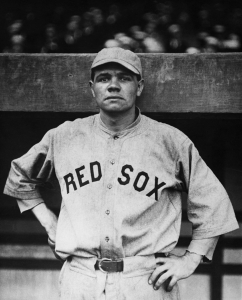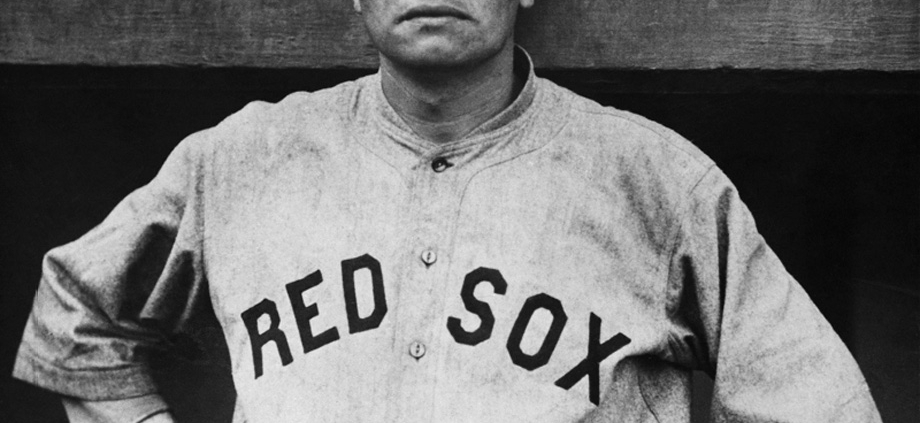June 13, 1916: Red-hot Babe Ruth goes on a tear against the Browns
 He was just 21 and only in his second full season but Babe Ruth was already proving to be a man who could do the undoable.
He was just 21 and only in his second full season but Babe Ruth was already proving to be a man who could do the undoable.
As a rookie in 1915 he won 18 games for the World Series champion Boston Red Sox. He did pretty well at his side job as a hitter, too, finishing in the top 10 in the American League in home runs — in fewer than 100 at-bats. The young man was arguably “the hardest hitting pitcher in captivity,” as one sportswriter put it.1
In slight contrast, Ruth’s 1916 season was off to a nice start but was lacking in supernatural feats. He was pitching well but at the plate he flailed away fruitlessly, as most pitchers do. That is, until a mid-June offensive outburst — capped by a brilliant day against the St. Louis Browns — served notice to baseball that, for Ruth, almost anything was possible.
With the season nearly one-third complete, the standings were all topsy-turvy. The Indians and Yankees, who finished 44½ and 32½ games out respectively in 1915, stood atop the AL while the Red Sox, Tigers, and White Sox — the top three teams from a year earlier — were sandwiched in the middle of pack, hovering around .500. Boston’s trade of a disgruntled Tris Speaker to Cleveland before the start of the season set off some of those seismic shifts. “When Speaker was sold by the Red Sox many cried that Boston had lost the most important cog in its flag winning machine,” wrote J.J. Alcock in the Chicago Tribune in late May. “The season is too young to draw a definite line on the present strength of the Red Sox. But the effect of Speaker’s addition to the Cleveland team is already a known quantity.”2
While the rest of the league was in tumult, it was business as usual for the Browns. They came in 21-26 and appeared to be on their way to their typical 90-loss season. That would change. Manager Fielder Jones, in his first year taking over for Branch Rickey, would turn things around and steer his club to a winning record — the only time that happened for the Browns between 1909 and 1920.
Ruth was the starting pitcher on this partly cloudy, 80-degree afternoon at Sportsman’s Park. He entered the game 8-3 with a 1.90 ERA and shutouts in three of his last five starts. He was building upon the promise he had shown as a rookie and now was maturing into one of the truly premier pitchers in the league.
Taking the ball for St. Louis was Dave Davenport, a foul-tempered, hard-drinking, 6-foot-6 right-hander from the Louisiana bayou. He came to the Browns from the Federal League’s St. Louis Terriers, where he led all major leaguers with 392⅔ innings pitched in 1915. With the exception of Grover Alexander, no other pitcher in baseball came within 50 innings of him. This was his 12th start and 21st appearance as a member of the Browns and thus far it had not gone well. He was 2-5 with a subpar ERA of 3.35 in a time when runs were hard to come by.
Boston got to Davenport quickly. With Mike McNally on second and one away, Duffy Lewis drew a walk as the pitch got past catcher Harry Chapman, allowing McNally to sprint to third. Doc Hoblitzell’s grounder to second forced Lewis, but his aggressive slide prevented a double play and enabled McNally to score the first run of the afternoon.
Ruth cruised through the first two innings before stepping in to lead off the top of the third. Boston’s sluggish season was attributable in small part to Ruth’s own struggles at the plate. He entered June batting .171 with no home runs and just two extra-base hits in 38 plate appearances. However, over the last few games he had begun to crank it up. He went 3-for-3 in a loss to Detroit on June 9, including a majestic home run deep into the bleacher seats at Navin Field. The Detroit Free Press marveled, “There have been a lot of pokes into the 25-cent section since the park was built but none ever [landed] so close to the flagpole.”3 On June 10, in the first game of the Browns series, manager Bill Carrigan called upon Ruth to pinch-hit but, for reasons lost to time, called him back to the dugout with a 1-and-1 count. On June 12 the Babe’s three-run pinch-hit homer was all the offense the Red Sox could muster in a 4-3 loss.
Now Ruth faced Davenport. St. Louis center fielder Armando Marsans and right fielder Ward Miller were playing back almost against the fence, but it wasn’t deep enough, as Ruth lifted a Davenport offering into the seats for a 2-0 lead. It was Ruth’s third homer in his last five plate appearances and it tied him for second place in the AL in home runs. (In fact, only 12 American Leaguers would hit more than three home runs all year.)
Harry Hooper followed with a walk, went to second on McNally’s sacrifice, crossed over to third on Lewis’s infield single, and then one out later came in to score when Tillie Walker drew a bases on balls and the pitch again eluded poor Chapman, who hurt his hand trying to make the stop. With that, Fielder Jones swapped in a new battery — pitcher Ernie Koob and catcher Hank Severeid.
In the fourth, after Hal Janvrin singled, Ruth slashed a base hit to right field, his sixth hit in his last six at-bats. Janvrin scooted around to third as Miller cut down Ruth trying to stretch it into a double. Hooper’s single plated Janvrin to make it 4-0.
As good a pitcher as Ruth was, he could get a little wild sometimes and control would be his undoing on this day. He walked three men through the first five innings before it all fell apart in the sixth. He opened the inning with walks to Miller and George Sisler. After Del Pratt struck out, Marsans singled to right to load the bases and then Ruth walked Ernie Johnson to force in a run. Carrigan called to the bullpen for Ernie Shore, who retired the next two batters to prevent any further damage. Boston got that run back right away on McNally’s RBI single in the seventh, and the score was 5-1.
Almost exactly a year later Shore would etch his name into baseball lore when he worked nine perfect innings in relief of Ruth, who was ejected for clobbering an umpire after a leadoff walk. Shore was far from perfect against the Browns but he muddled through. Back-to-back walks to lead off the bottom of the seventh turned into two more St. Louis runs. In the ninth Miller rapped a single to lead off but third baseman Larry Gardner made a leaping stab of Sisler’s sizzling liner and turned it into a double play to put a damper on the home crowd’s hopes. Shore retired Pratt to end the game and sew up a 5-3 victory.
Ruth also was hit by a pitch in this game, meaning he had reached base safely in 11 of his last 12 plate appearances. His OPS stood at .916, which would mark his statistical peak for 1916. These June home runs would be Ruth’s only three of the season and, in fact, 1916 proved to be one of the least impressive offensive years of his career. But he did iron out his wildness to finish 23-12 with a league-best 1.75 ERA as the Red Sox pulled it together and stormed to their second consecutive World Series title.
Sources
In addition to the newspaper sources cited in the Notes, the author used Baseball-Reference.com and Retrosheet.org.
The author also reviewed the following newspaper articles for play-by-play and other information:
Martin, Edward F. “Scott’s Drive Wins for Red Sox in 10th,” Boston Sunday Globe, June 11, 1916.
Martin, Edward F. “Shore Brings Red Sox to Victory,” Boston Globe, June 14, 1916.
O’Connor, W.J. “Browns’ Attacking Methods Fail With Men On; Lack of Daring Makes Contest Dull,” St. Louis Post-Dispatch, June 14, 1916.
Shannon, Paul H. “Browns Beaten by Red Sox 5-3,” Boston Post, June 14, 1916.
Notes
1 Paul H. Shannon, “Red Sox Divide With the Browns,” Boston Post, August 11, 1915.
2 J.J. Alcock, “Pep of Speaker Pushes Indians Into Top Place,” Chicago Tribune, May 21, 1916.
3 E.A. Batchelor, “Burns Hero of Another Tiger Win,” Detroit Free Press, June 10, 1916.
Additional Stats
Boston Red Sox 5
St. Louis Browns 3
Sportsman’s Park
St. Louis, MO
Box Score + PBP:
Corrections? Additions?
If you can help us improve this game story, contact us.


